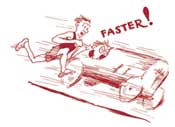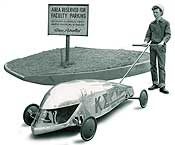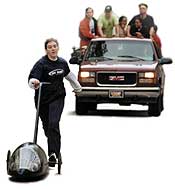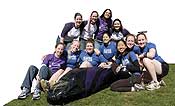For many students, it’s bigger than commencement. And for many alumni, it’s even bigger than Homecoming.
Mention the annual Spring Carnival Buggy Races to students and alumni and their faces light up brighter than a flashlight-holding flagger on the course during 6 a.m. freerolls. They fondly recall the commitment, camaraderie, intrigue, excitement and suspense. They love to talk about it, but only to a point. Buggy details and specifics are for team members only. If they told you, they’d have to kill you.
“Anything that can be gleaned about an organization’s buggy may be useful,” says a 1998 alumnus who, of course, wishes to remain anonymous. He won’t elaborate, but he gladly will go on about THE tradition of all Carnegie Mellon traditions.
“Buggy gives students, regardless of their major, a chance to participate in something that no other college or university has on its campus. No one comes close to buggy. Everyone that participates will tell you that it was the most memorable thing they ever did at Carnegie Mellon. I met some of my closest college friends through buggy and still maintain friendships to this day with fellow alumni and current participants.”
Since 1920, when primitive “pushmobiles” were first built to race around campus during Campus Week, student groups have been eating, drinking and . . . not sleeping buggy. Up before dawn for weekend practices, interdisciplinary student teams work countless hours, year-round. They use their engineering skills, design expertise, ingenuity and yes, duct tape, to build the sleekest and fastest buggy possible, and their athletic skills to push and drive them around the famous eight-tenths of a mile course—up Hill 1 and 2 of Tech Street, down and around Schenley Drive, the hairpin turn into the “chute” on Frew Street and the long straightaway for Hills 3, 4 and 5.
Once four-wheeled miniature racecars, today the term buggy is really a misnomer. Built from various compositions of “stuff” that “might” include fiberglass, carbon fiber, Kevlar and epoxy, these three-wheeled aerodynamic, missile-like vessels, driven by petite women strapped prone inside, reach speeds of up to 30 miles per hour. Hey, these ain’t your grandfather’s buggies.
“Driving is an unbelievable experience,” says this year’s Sweepstakes Chairperson Sara Player, a former driver for the Carnegie Involvement Association, better known as CIA. “Thirty miles per hour doesn’t feel so fast when you’re riding in a car, but when you’re just a couple inches off the ground you’re zooming.
“The people who would most likely understand what it’s like are street lugers and astronauts. You’re strapped in, and small and precise movements are critical. The hairpin turn up toward Scaife is crazy,” she says.
Yes, still crazy after all these years.
Goin’ Buggy
A brief chronological look at buggy history.
1920

The first buggy races are held as part of the first alumni celebration, a springtime Campus Week.
1923

Amusing buggies, like Delta Upsilon’s “Fish” and Printing Management’s “Bathtub” disappear for the most part after 1923.
1928
Campus Week is replaced by Spring Carnival and a booth competition is introduced. Frew Street is completed and the course takes on its present-day format: 4,412 feet long with a 2,500-foot downhill stretch that decreases 60 feet in elevation.
1938
As late as 1938, the Hill 2 pusher rides on the buggy through the free-roll section of the course.
1953

Alpha Tau Omega’s “Golden Goose” brings a radical change in buggy design. It places the driver prone, face forward in a buggy built low to the ground.
1960
Delta Upsilon enters a keg of beer mounted on four wheels.
1965

Sweepstakes is featured in a March 1965 story in National Geographic entitled “Pittsburgh, Pattern for Progress.”
1979

Women’s heats are run for the first time.
1986
Jerry Lewis is grand marshal of Sweepstakes ’86.
1989
The two-wheeled buggy is eliminated.
2004

Kappa Kappa Gamma enters the first all-women’s team in buggy history.
Related Links:
Sweepstakes 2005
Spring Carnival



